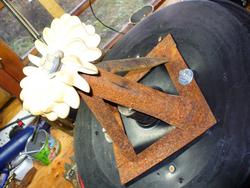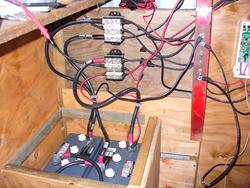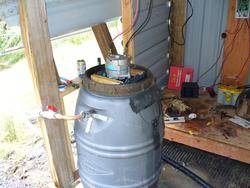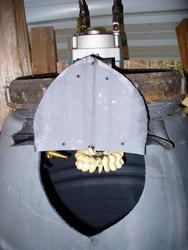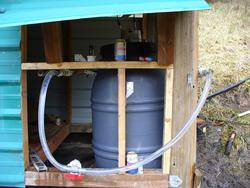Home Brew Hydro : MKIV
A small hydroelectric project.
MK I: Early turbine and generator
MK II & III: New alternator and couplers
MK IV: shaft bearing and real world use
Coanda Effect water intake (New Rain Update!)
alt.energy.homepower discussion
So I set out to solve the spin washer effect, where the shaft was creating a pretty disturbing vibration at higher RPM. Also I didn't want the alternator to carry the lateral force all on its own -- heck those things aren't cheap and even though it did work I knew running it like that would reduce the life span significantly. I scouted around for something to hold a bearing near the end of the shaft and take the load off a bit.
I had various angle iron chunks setup with a number of different bearings but then a buddy of mine gave me this rusty bit of genius. Some old guy had made this as a support for his motor home and it ended up at my friends garage. It fit PEFECT!
Here it is mounted. I gave it an electrolytic derusting session and hit it with agave rustolium. I couldn't find a teflon sleeve bearing that would fit so I ended up using a simple brass bushing to stabilize the shaft. I might upgrade that at some point, but it seems to work and it gets constant water lubrication so for now it'll do.
OK down to the nightmare that is wiring. I scored a couple of high amp Marathon block splicers that made life easier. These suckers are HUGE so they'll handle pretty much anything. 350 amps or something ridiculous like that. I know it looks messy but compared to splicing the wires to each other this is much much nicer.
The heart of the system are two Werker L16 type batteries. Not as groovy as trojan bit they fit the budget.
Also took a big chunk of steel from an old saw mill and made a giant grounding bar. Its grounded to a copper rod outside and everything else to it as well. When you look at any wiring diagrams for integrating solar and hydro or wind they've got got a million ground wires going everywhere. this way its all in one spot.
Here it is actually making power for the house. My inverter is a super sucky square wave 800 watt chinese one and it makes horrible RF noise so I scored a used Filter Concepts model CF151F that i'm running the power through. It makes a huge difference -- I can actually listen to AM radio in the house now!!!
Here is the charge controller for the solar panels that are wired into the werker battery bank. Its winter so they aren't doing much but they are adding a little juice during the daytime.
Below that is the xantrex c35 setup in diversion mode so it just monitors the batteries and shunts any extra power I might make (ha!) to a DC heater. Rather than spend a fortune on those big switches i've just been using hella battery cut off switches like you'd use in race cars to turn various circuits on and off.
So here's how an olive barrel, nearly a 1/2 a years worth of screwing around, and a lot of advice turned water and gravity into electricity.
Watts and Volts and Lessons Learned
So everyone keeps asking me "how much power are you making?". Well how about "more than I expected" and "less than I'd like".
Its early days still with this system. According to the alternator manufacturer it needs to run for quite a while to get totally broken in. Also, being among those who still believe that electricity is probably either related to faerie majick or maybe something related to the Devil or Aliens I'm not quite certain how much power its producing as of yet.
Tonight is the first long term test of the hydro system. I had drawn down the battery bank to 11.5 volts over the last day and since it was raining I could run full bore with no worries about loss of water. After 3 hours i'm up to 12.3 volts on the bank with no draw (i'm on the generator). I don't know how much that is but we're clearly charging so i'm happy.
Lessons:
Voltages and charging: The alternator I bought was probably a bit ambitious for the RPM target i was hoping to hit with it. I could never get above 12 volts with the thing spinning as fast as I could get it to go. Finally I figured out that you can't charge a 12 volt battery when sending less than 12 volts into it -- DOH! However, once I moved two six volt batteries and hooked the output to one of the six volt batteries the alternator got a load and started doing the business. This was key:
"Batteries have a wonderful ability to balance themselves out when connected together so even though your only charging one of the batteries in the bank, the effect of that charge will be felt across all the batteries in the bank effectively charging all the batteries." - windbluepower.com
And so rather than trying to charge the whole bank with around 11 volts I hooked the alternator to one of the six volt batteries pushing about 10 volts into it .. voila.. its loaded and charging. These are the kind of things they need to write out for idiots like me in big bold type. This is still not ideal -- I should have bought a different alternator with a higher voltage curve for the RPM i could give it, but heck.. it'll do for now.
Spin against the threads: A PMA alternator doesn't care which way it spins, but when you screw a coupler on the end, don't be an idiot and spin it with the direction of the threads. It'll just spin off. Like mine did the other day damn it. Then you have to re-align your jets and screw around because something so obvious wasn't so obvious when you did it.
Pipes and such: Avoid the whole PVC plumbing thing where you have to glue fittings together. Although your end result may look good, every time you throw a 90 degree angle in you're taking away power. Also, being an experimentalist like myself (aka you don't know what you are doing), every time you change the damn design you have to cut and re-glue fittings... its just a pain in the ass.
This flexible poly pipe is great. You can make corners without kinks and its much more forgiving than the old black waterline and you can get away from the annoying glued fittings and all the 90 degree joints. You undo some clamps, pull it apart, do some stuff and put it back together again. Bobs your uncle.
Conclusion: Having started this project with ZERO idea how all this stuff worked I'm now making *some* power and using it due to a giant hill and lots of water. Al Gore can kiss my ass .. so if you've got the resources its well worth trying .. and its fun. Wet but fun!
